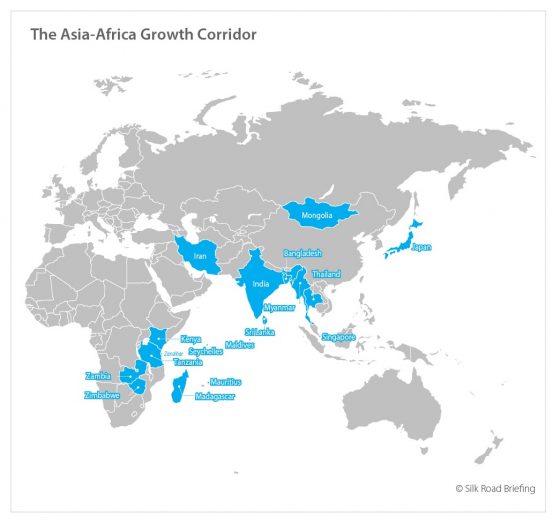Japan, India Propose Asia-Africa Growth Corridor as Alternate OBOR
The Indian Prime Minister, Narendra Modi has proposed the establishment of an “Asia Africa Growth Corridor” (AAGC) at the annual meeting of the African Development Bank, a proposal that has won strong support from Japan.
Both India and Japan face political difficulties on a regular basis with China, and neither have welcomed or been enthusiastic about China’s Belt and Road (B&R) initiative. Both are also major Asian economies with decades of diplomatic and trade experience in Africa.
The plan supported by India and Japan envisages the creation of new sea corridors that will link Asia-Pacific countries with African countries through multiple infrastructure programs in Africa and Southeast Asia. A number of jointly coordinated Indian-Japanese projects are already underway, some of which provide assistance in regions where China is starting to find the progress rather complex. These projects include the expansion of Iran’s Chabahar Port and the development plan of the adjoining special economic zone. Chabahar is to some extent a competitor to the China-funded Gwadar Port, further east in coastal Pakistan. Iran is also important to India as it is part of the International North-South Transport Corridor and via Chabahar, gives India access to Eurasia. Japan and India are also involved in Sri Lanka, where the two countries will likely join in the expansion project of the strategically important Trincomalee port. This is half way up the eastern coast, further north from the Chinese invested Hambantota Port. Interestingly, Japanese engineers had previously turned down the opportunity to invest in Hambantota, stating that the engineering difficulties were too costly to overcome. It remains to be seen whether the joint India-Japanese investments at Chabahar and Trincomalee prove better bets than the Chinese investments. India and Japan may also jointly develop the Dawei deep-sea port along the Thai-Myanmar border.
The AAGC plan covers countries and regions across Africa and Southeast Asia, although these have not yet been formally identified. However, with some knowledge of the region, and an understanding of where the Indians and Japanese are welcomed in Asia and Africa, we can reasonably surmise that the AAGC, should it come into existence, would encompass the following nations:
Asia: Japan, India, Mongolia, Thailand, Myanmar, Singapore, Bangladesh, Sri Lanka
Indian Ocean: Maldives, Seychelles, Mauritius, Madagascar
Middle East: Iran
Africa: Kenya, Tanzania, Zanzibar, Zambia, Zimbabwe
India has a long history of exchanges with Africa, and Prime Minister Modi has visited almost every country in Africa during his political career. However, the AAGC is still at the start-up stage. During the African Development Bank conference, Japan and India met separately with the member countries of the bank, discussing joint development plans for local infrastructure construction and capacity building. According to the annual budget proposal for the ADB proposed by the US government, the United States will work to revive two currently dormant infrastructure projects: the New Silk Road project covering Afghanistan and its neighboring countries and the Indo-Pacific Economic Corridor linking South Asia and Southeast Asia. India is expected to be a vital player in both projects. It remains to be seen how and if this will morph into the Asia-Africa Growth Corridor; if so, it may also take its place among the development plans of the new Silk Roads.
About Us
Chris Devonshire-Ellis is the Founding Partner and Chairman of Dezan Shira & Associates. He is based in Europe. The firm provides European businesses and governments with strategic, legal, tax and operational advisory services to SMEs and MNCs investing throughout Asia and has 28 offices across China, India and the ASEAN nations as well as St. Petersburg and Moscow. Please contact the firm at asia@dezshira.com or visit the practice at www.dezshira.com
Related Reading:
![]() India BriefingInvestment, Development & Business Research for Foreign Investors in India
India BriefingInvestment, Development & Business Research for Foreign Investors in India
Silk Road and OBOR Business Intelligence
Dezan Shira & Associates´ Silk Road and OBOR investment brochure offers an introduction to the region and an overview of the services provided by the firm. It is Dezan Shira´s mission to guide investors through the Silk Road´s complex regulatory environment and assist with all aspects of establishing, maintaining and growing business operations in the region.
China’s New Economic Silk Road
This unique and currently only available study into the proposed Silk Road Economic Belt examines the institutional, financial and infrastructure projects that are currently underway and in the planning stage across the entire region. Covering over 60 countries, this book explores the regional reforms, potential problems, opportunities and longer term impact that the Silk Road will have upon Asia, Africa, the Middle East, Europe and the United States.









